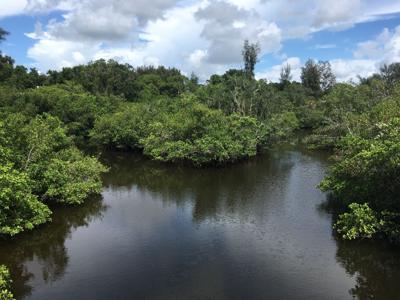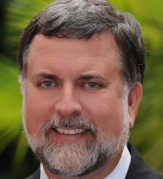Nokomis Area Civic Association water symposium well attended

The water quality in Hatchett Creek, seen here from the Legacy Trail bridge in Venice, and others like it that lead into the Gulf, are experiencing rising nutrient levels.
John McCarthy, Executive Director of Historic Spanish Point, emceed the event that drew more than 100 attendees.

He began the evening with a short slide presentation documenting changing newspaper headlines from the 1920s, when hundreds of thousands of Gulf fish were caught and transported north, to today’s headlines on beach closures due to fecal bacteria, flesh eating bacteria incidents, and the area’s ongoing recovery after last year’s devastating red tide bloom.
Three experts gave attendees advice on how to reduce pollution of Gulf waters and do their part to change those headlines. Here’s a summary of what they had to say.
CLEAN SEPTIC TECHNOLOGY IS HERE

Abbey Tyrna Water Resource Agent, UF/IFAS Extension & Sustainability
Florida’s water table is very close to the surface, making our water supply more vulnerable to faulty septic systems and nutrient overload. With 40,000 septic systems in Sarasota County, it’s estimated to cost roughly $150 million to convert them all.
But is conversion necessary? Clean septic technology is already available, and can reduce nutrient discharge to a negligible level. But it costs from $10,000-$20,000. The technology essentially adds another cleansing tank and enhanced drain fields to the system. There’s talk about establishing grant programs to help finance some conversions.
There are less expensive fixes.
Not all septic tanks are equal. Some aren’t near the coast and don’t pose as much of a threat to contaminating the water supply. Some don’t leak at all and do the job intended. The focus should be on septic systems that pose the most risk.
Dr. Tyrna gave the following myth-busting tips for a better working septic system:
Myth: The more I pump it out, the better.
Not so. If you overpump, it hurts the biological processes at work in the tank and in the leach field.
Myth: Septic tanks should be cleaned every month.
No. Septic tanks should be pumped every three to five years.
Myth: Nothing can be done until I hook up to central sewer.
More advice: Never flush a wipe, even if the advertising says it’s okay. They weave together with other materials to cause blockages. Never put fats, oil or grease into a septic system. They also impair the biological processes underway in the septic tank. And never park on a leach field. It compacts the ground, impairing the drainfield’s ability to convert nutrients.
CLEAN WATER STARTS WITH HEALTHY SOIL

Steven Suau
Principal and Managing Partner, Progressive Water Resources
All algaes are fed by nutrients. Some potential sources of nutrients are excess fertilization, wastewater not treated for nutrients, biosolids, and onsite wastewater treatment and disposal systems (septic).
Here’s how to nurture soil without the excess nutrients.
Here are two simple passive media anyone can use to help in the process of denitrification: woodchips and biochar.
Blending wood chips and sawdust, and mixing it in with sand. Then lay dirt over it. It will denitrify the soil.
In one instance, the sawdust/sand mix intercepted 60 percent of the nutrients that went through it.
Biochar is a another wonderful soil to add to yours. Basically, when you have a forest fire, it creates charcoal. It’s nature’s way of getting organic carbon back into the soil. Biochar has been shown to reduce nutrients in only 15 minutes.
The good news is there is just a lot of opportunity for denitrification to happen.
RESEARCH YES, BUT IT’S TIME TO ACT

Jon Thaxton
I would suggest we are not entering any new or uncharted waters with the information we are hearing from recent water quality summits.
In 1986, a group from Mote Marine pledged to hold a water summit. Seven months later New College hosted the Sarasota Basin Symposium. They talked about wastewater, stormwater runoff, and sea grass enhancement.
That resulted in a 1987 paper on (the subject) and another in 1988 on the “Identification of Resource Management Problems and Issues in the Sarasota Bay Watershed.” What did these reports cover? Development pollution, sea level rise, stormwater, and wastewater. That inspired the creation of the Sarasota Bay National Estuary Program.
In 1993, a group associated with that program published a report which called for a significant decrease in nitrogen, improvements in wastewater treatment, removal of septic tanks, and better treatment of stormwater.
You’re noticing a trend here.
Then in 2012, New College and the Sarasota Bay National Estuary Program focused on reducing nutrients and the creation of Florida Friendly Yards.
Finally, in 2014, New College and the Sarasota Bay National Estuary Program published their most recent conservation plan, called “The State of the Bay Report.” What did they identify as the most needed action of this community? Stormwater, wastewater, et cetera.
We have wastewater treatment systems that are grossly underperforming.
We have taken the position for the last nine years that we are not going to fine polluters.
Email: ggiles@venicegondolier.com